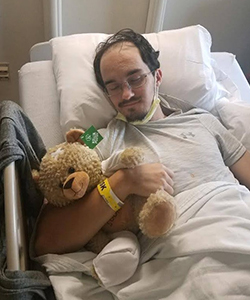
Popular Locations
- Yale New Haven Children's Hospital
- Yale New Haven Hospital - York Street Campus
- Yale New Haven Hospital - Saint Raphael Campus

Published June 25, 2025

It started with a headache – one so fierce it stopped him in his tracks.
On a quiet October night in 2020, with the world already gripped by the fear and isolation of the pandemic, 23-year-old Vincent Zelinsky felt an alarming wave of numbness creeping through his body. Feelings of a panic attack and anxiety took over and the left side of his body which tingled, then went numb.
Deep down, Vincent knew something was very wrong. He grabbed his phone and dialed 911 and that call saved his life.
“I told the dispatcher I had the worst headache of my life and that’s all the dispatcher needed to know. They sent an ambulance just based on that alone,” said Zelinsky.

Vincent recovers in the hospital from his procedure to treat a massive stroke.
He gradually climbed upstairs to tell his mother but lost his vision from his left eye. When paramedics arrived at his door, Vincent had lost all feeling on the left side of his body from a massive stroke.
Rushed to Yale New Haven Hospital (YNHH), Vincent was met by Charles Matouk, MD, vice chair of Clinical Affairs of Neurosurgery and chief of Neurovascular Surgery at YNHH.
“We were already in the Operating Room (OR) waiting for Vincent. We knew he was in rough shape and needed emergency surgery,” said Dr. Matouk.
Dr. Matouk diagnosed Vincent with an arteriovenous malformation (AVM) which is a tangle of abnormal blood vessels Vincent was born with. These blood vessels bypass the normal capillary network that connects arteries and veins directly. These malformations can occur in various parts of the body, including the brain.
“Most of the time, a person will not have symptoms with an AVM, but over time, through age or stress, it will lead to fragility and rupture in the blood vessels which is what happened with Vincent,” added Dr. Matouk.
Time was of the essence for Vincent who was quickly transported from the emergency department to the OR. According to Dr. Matouk, most of the time, AVM’s do not require emergency surgery, but if there is bleeding inside the brain, it is urgently required.
If his AVM had not been treated immediately, it could have led to uncontrolled bleeding, paralysis or even death.
Dr. Matouk placed an external ventricular drain in Vincent’s skull to drain cerebrospinal fluid (CSF).
“We were able to bring catheters through a puncture site in Vincent’s leg all the way to that spot in his brain and inject the AVM with medical grade glue to stop the bleeding,” added Dr. Matouk.
Vincent remained in the intensive care unit (ICU) for about 10 days under sedation.
Now 28 years old, Vincent's time at YNHH remains a blur and visitations were restricted at the time. He is sure about one thing - he was given a second chance at life.
“There’s no number of words that I can string together to properly express my gratitude to Dr. Matouk. I owe half of my life to Yale New Haven Hospital,” added Vincent.
Despite making great strides in his recovery, Vincent still faces vision challenges that prevent him from driving.
“With rehabilitation overtime, your body can rewire and heal. Some of the function comes back but you might not go back to the way you were because part of your brain was injured,” added Dr. Matouk.
No matter what a person’s age is, Dr. Matouk wants everyone to know about FAST, an acronym used to help identify the signs of a stroke.
FAST stands for:
While it is very difficult to predict a survival rate since everyone’s health condition varies, there are factors, however, that can play a role.
Age can contribute to recovery time, the severity of a person’s stroke, the timeliness of treatment, and something called collaterals.
“I compare common strokes – where a blood vessel in the brain gets blocked by a clot – to driving from New Haven to Greenwich. Blood can get to a part of the brain that it supplies via two routes – the main road or backroads. In this analogy, Interstate 95 in the main road and the Merritt is the backroad (or collaterals). Imagine if I-95 is blocked, so now all that traffic that was on I-95 is being diverted to the Merritt,” added Dr. Matouk. “Some people are born with a Merritt that has two lanes, and some people are born with a Merritt that has four lanes. Either way, you have a better chance to getting to Greenwich if I-95 is opened quickly – but your chances are even better if you were born with a four lane Merritt.”
Dr. Matouk emphasizes that maintaining a healthy lifestyle through regular exercise and proper nutrition not only speeds up recovery but is one of the best defenses against having a stroke in the first place.
Learn more about YNHH’s Stroke Center